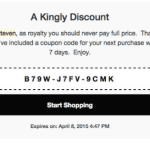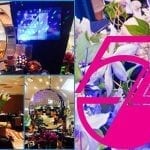Around the country this year, lots of happy moms were delighting in floral gifts — and lots of equally happy, if totally exhausted, retail florists are now delighting in positive sales numbers. That’s the picture painted by two separate surveys — one aimed at SAF members and another targeted at consumers.
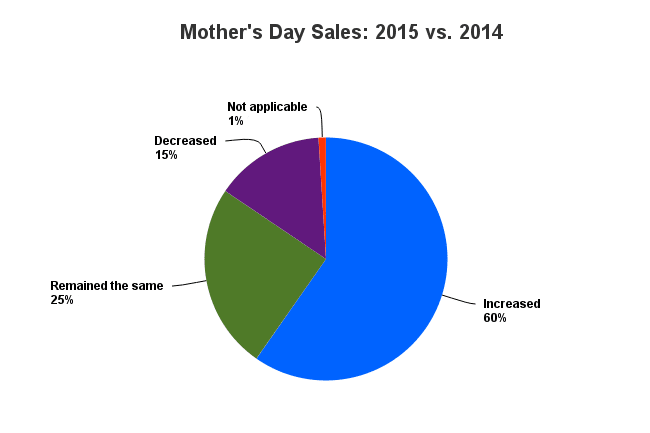 Source: SAF Mother’s Day 2015 Survey. Emailed May 18 to all SAF member retailers. Based on 207 responses |
Sixty percent of respondents to SAF’s 2015 Mother’s Day survey experienced an uptick in sales this year, a figure that closely aligns with numbers collected immediately after the holiday in SAF’s “Gut Check” survey. Among respondents who saw an increase, 53 percent experienced a rise between 1 percent and 10 percent.
Meanwhile, a quarter of respondents said sales were on track with 2014 returns and 15 percent said they saw a drop. (Of those who saw sales decline, the majority, 61 percent, weren’t sure yet of the exact drop off or marked the question “not applicable.”)
By comparison, last year, the SAF Mother’s Day survey found that almost 53 percent of respondents reported a sales increase, about 27 percent said sales were flat and 20 percent said they were down.
The positive findings complement a separate consumer survey, conducted for SAF by Ipsos Public Affairs, which found that more people purchased holiday floral gifts this year and those who did shop, spent more.
In fact, 35 percent of Americans bought fresh flowers and plants as gifts for Mother’s Day this year, according to the survey, compared to 31 percent in both 2014 and 2013.
At the same time, the average floral gift purchase was just over $50, compared to $41 in 2014, for floral purchases made across platforms, including grocery stores, Internet floral providers, etc. When considering transactions only at retail florists, the survey found average sales to be significantly higher, at $70, up from $63 in 2014. (Respondents to the SAF story indicated a lower average transaction of about $65, compared to $60 last year).
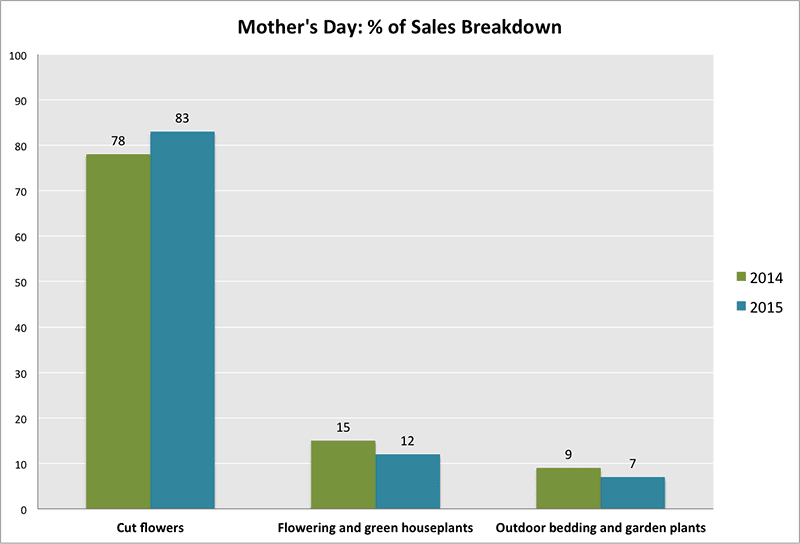 Source: SAF Mother’s Day 2015 Survey. Emailed May 18 to all SAF member retailers. Based on 207 responses |
Meanwhile, Ipsos found the median purchase price remained consistent at $30 for both 2014 and 2015, indicating that those consumers inclined to spend more than $30 on a more lavish gift for mom (or sis, grandma, etc.) increased their spending significantly over last year’s purchasers.
“This year’s survey results show that flowers and plants remain one of the most popular gifts for Mother’s Day, and that consumers are spending even more to celebrate mom,” said SAF CEO Peter Moran.
Here’s a more in-depth look at both survey results:
Overall Returns. In addition to asking respondents about overall sales movement, the SAF survey queried members about specific trend lines.
Compared to last year, for instance, 45 percent of respondents said the number of transactions increased and 55 percent said their average sale was higher than 2014 results. About three-quarters of respondents said they held delivery charges steady; and 67 percent said they promoted their shop about the same as last year.
Meanwhile 48 percent reported their wire-in orders decreased (21 percent said they were flat and 25 percent said they were up) and 43 percent said their wire-out orders were on par with 2014 (41 percent said they were down and 12 percent said they were up.)
(Representatives from FTD and Teleflora shared information on their average order values in the May 13 issue of Ebrief; as a publicly traded company, 1-800-Flowers.com declined to comment. You can read anecdotal stories about the challenges, trends and successes surrounding the holiday, pulled from the SAF “Gut Check,” in the same issue.)
Respondents also reported that, on average, nearly half (49 percent) of orders came in via phone. About 19 percent of orders stemmed from walk-in business, 16 percent from a shop website and 17 percent from wire services or order-gatherers. (About 3 percent came from other, unspecified sources)
Cut flowers, which represented an average of about 78 percent of purchases among respondents last year, became an even more popular selection this year: Respondents said they made up on average about 83 percent of sales, dwarfing flowering and green houseplants (12 percent) and outdoor bedding and garden plants (7 percent).
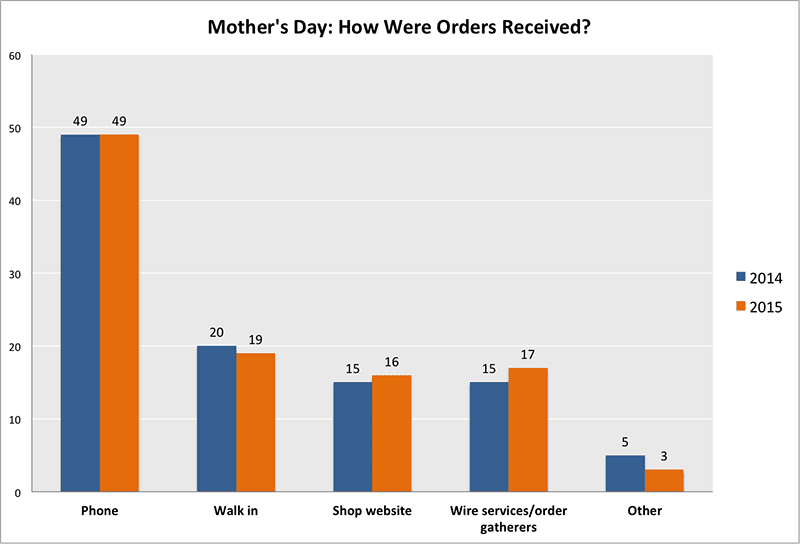 Source: SAF Mother’s Day 2015 Survey. Emailed May 18 to all SAF member retailers. Based on 207 responses |
The Ipsos survey produced similar results when it came to consumer preference for floral gifts: 72 percent of respondents said they purchased fresh flowers as a gift. Outdoor bedding or garden plants (30 percent) and flowering houseplants (28 percent) were the next most popular floral Mother’s Day floral gift. Each of these show similar purchase patterns to 2014 results (69 percent fresh flowers, 33 percent outdoor/garden plant, 26 percent flowering houseplant).
Eyeing the Competition. Among respondents to the SAF survey, 39 percent ranked order-gatherers as their top competitor and 68 percent ranked them among their top three. Supermarkets earned top competitor ranking by 24 percent of respondents; 70 percent ranked supers among their top three competitors. Next in line were direct-ship options, cited as being one of the top three biggest competitors by 47 percent of respondents and no. 1 by 13 percent. Cited less frequently as a top three competitor (by 32 percent or fewer) were, in declining order: other florists, mass merchandisers, non-floral businesses and garden centers. (Street vendors, fundraising groups, charitable organizations and Farmer’s Markets were cited in the top three by six percent or fewer.)
The Ipsos survey found that the most frequent purchase channel for floral gifts this Mother’s Day was supermarkets/grocery stores (45 percent). This was a significant increase compared to 2014 (35 percent purchased from a supermarket/grocery). Garden centers (18 percent), mass merchandisers (17 percent), and retail florist shops (17 percent) were the next most common places Mother’s Day floral gifts were purchased. Lower on the list: home improvement centers, 11 percent (compared to 18 percent in 2014), national Internet floral services, 10 percent (also 10 percent in 2014); and national toll-free floral services, 8 percent (compared to 5 percent in 2014).
Overall, the Ipsos survey found that retail florist shops saw a slight decline in 2015 (17 percent vs. 20 percent in 2014); however, the results are comparable to previous years (17 percent in 2013 and 15 percent in 2012).
Breaking Down Results.
By location According to the SAF survey, 61 percent of florists who self-identified as having “urban” locations reported a sales increase — 20 percent reported a drop and about 19 percent said they saw flat results.
Among suburban florists, 56 percent reported an increase, 29 percent reported results similar to 2014 and 15 percent saw a drop. Sixty-one percent of small-town florists said they saw sales increase and 29 percent said sales were flat; only 6 percent of this group reported a decline and 3 percent were unsure of the shift. Sixty percent of rural florists reported an increase — 20 percent saw a drop and 20 percent said sales were about equal to last year.
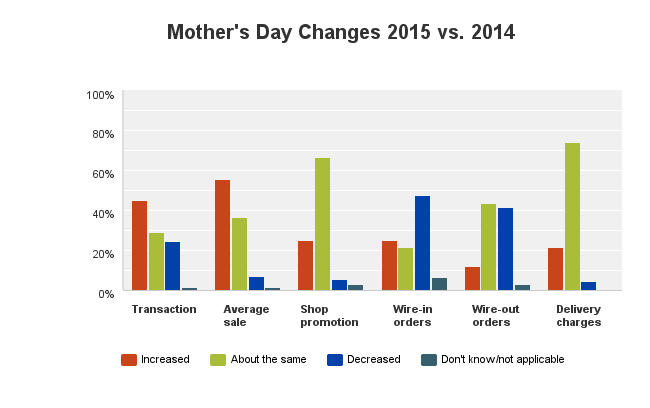 Source: SAF Mother’s Day 2015 Survey. Emailed May 18 to all SAF member retailers. Based on 207 responses |
The Ipsos survey showed some interesting regional differences emerging in 2015. Gains were seen in the South and West regions, while slightly lower levels were seen in the Northeast and Midwest.
Consumers in the South were more likely to make a floral gift purchase for Mother’s Day this year (33 percent) compared to 2014 (26 percent). They also spent $60 on average for their gift compared to just $40 last year.
Those in the West showed a similar pattern, with an increased level of purchases (41 percent this year vs. 30 percent in 2014) and spending more on average ($51 vs. $37).
Midwest region residents showed slightly lower purchases (34 percent vs. 36 percent) and lower spending ($38 vs. $40). Consumers in the Northeast also showed slightly lower purchases (33 percent vs. 36 percent), and at a lower level of spending ($43 vs. $49).
By size Though results were still positive, smaller businesses, those with less than $300,000 in annual sales, were less likely to report increased sales, compared to those businesses with $1 million or more in annual sales.
Among the smaller group, 61 percent reported an increase, about 18 percent said sales declined and about18 percent said they held steady. For the larger businesses, 71 percent reported increase, 19 percent said they were about the same and 10 percent said sales dropped.
Purchaser and Recipient Trends. Consumers most likely to purchase fresh flowers and plants for Mother’s Day were young adults age 18 to 34 and those in households with children (51 percent each), according to Ipsos results.
Both of these groups did more flower and plant buying this year vs. Mother’s Day 2014 (37 percent and 39 percent respectively).
In addition, 64 percent of purchasers said they were buying a gift for their mother, while 23 percent bought flowers for their mother-in-law, and 21 percent bought a floral gift for their wife.

